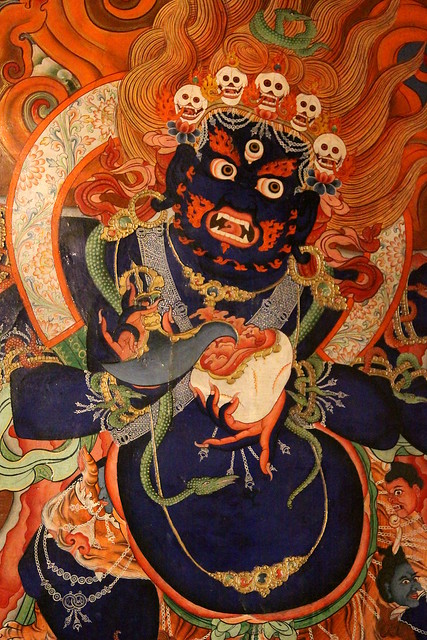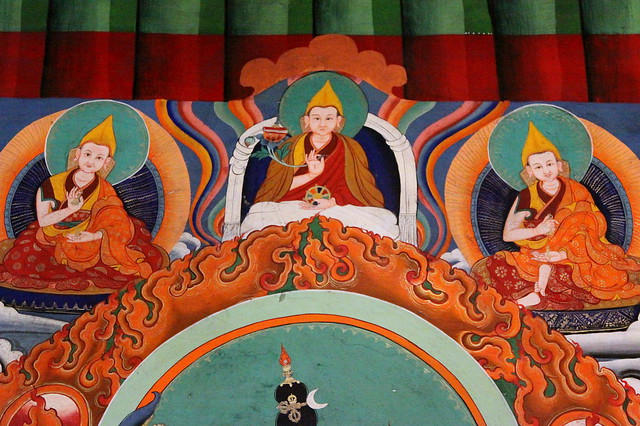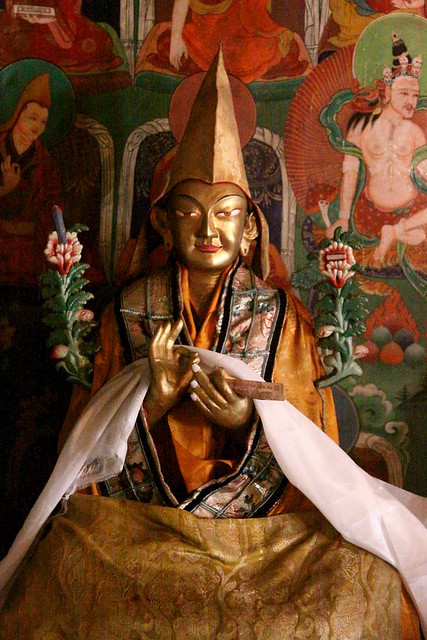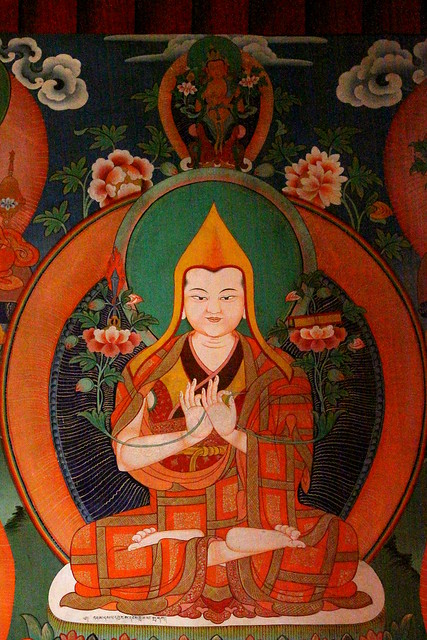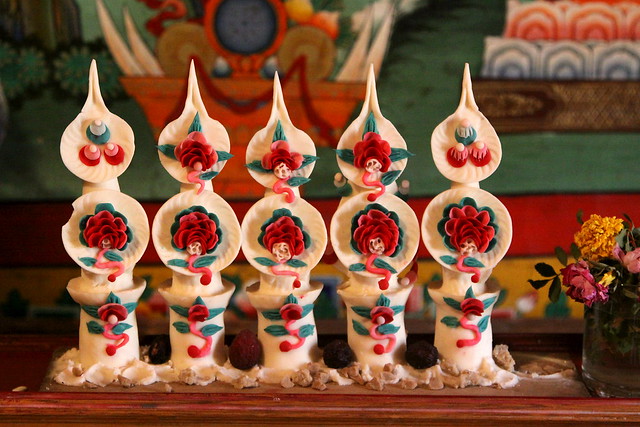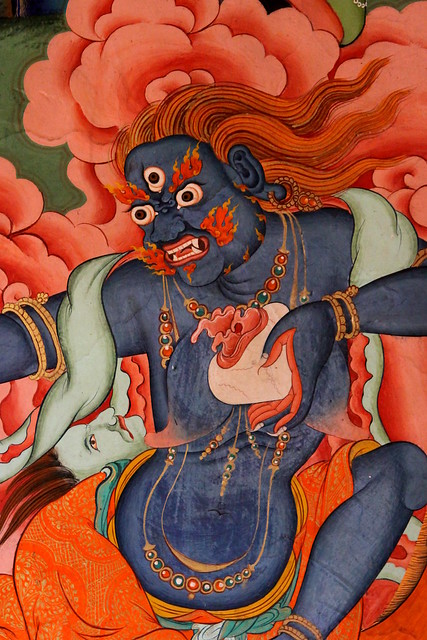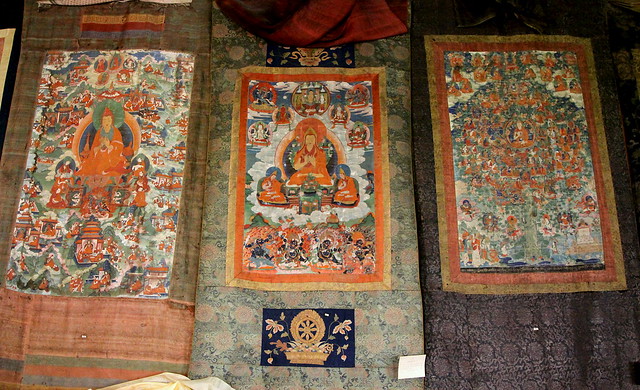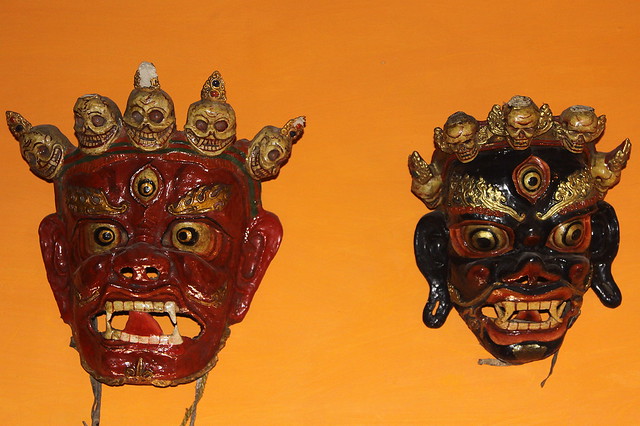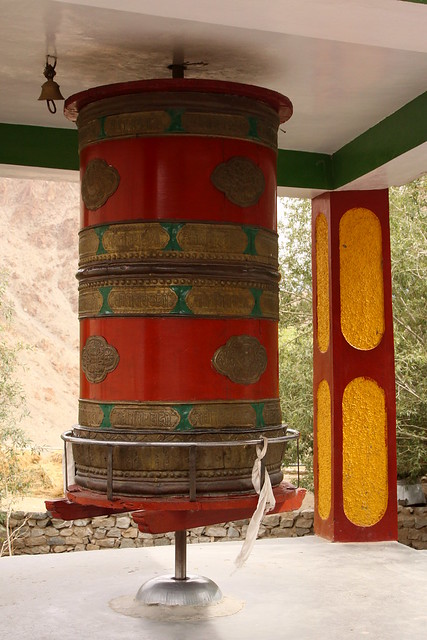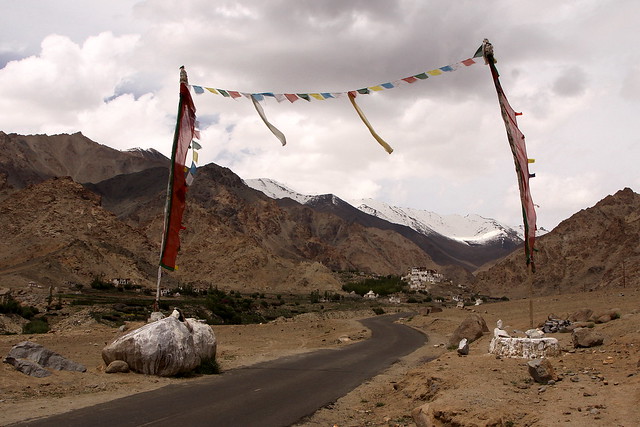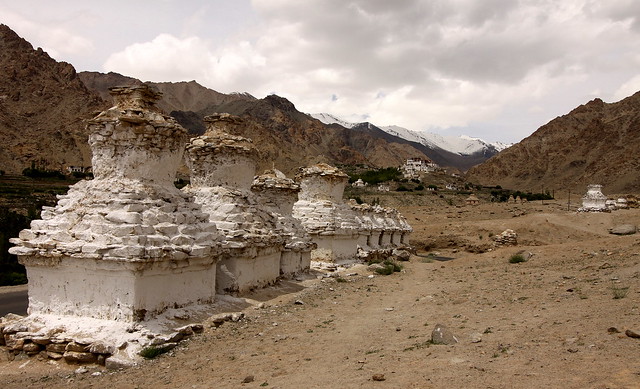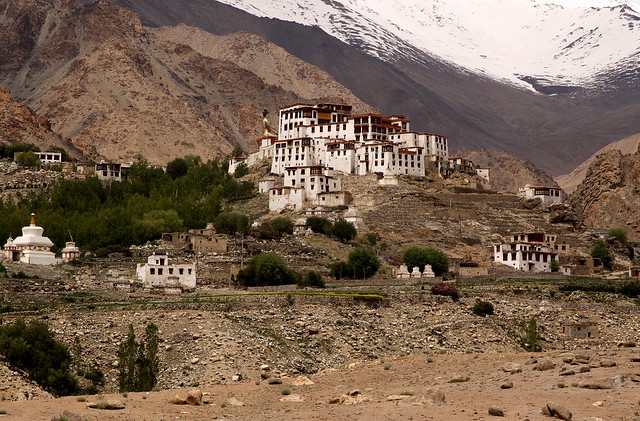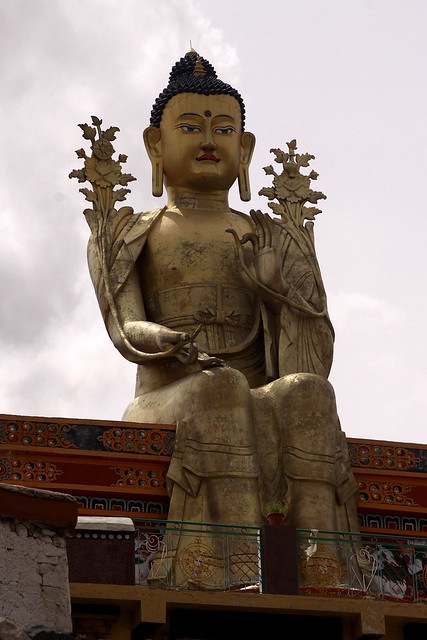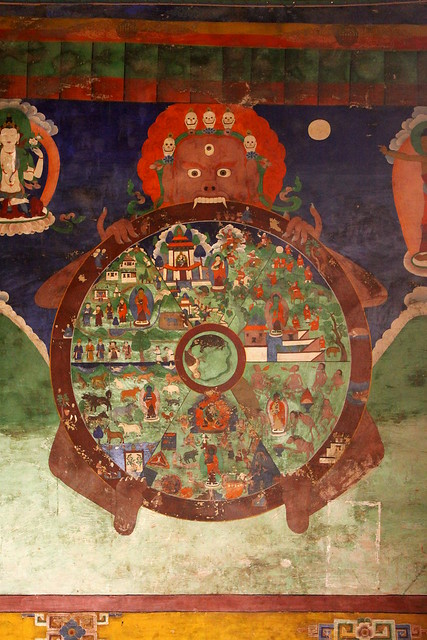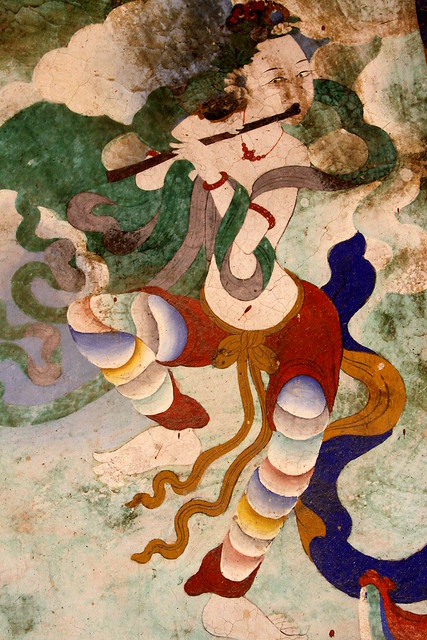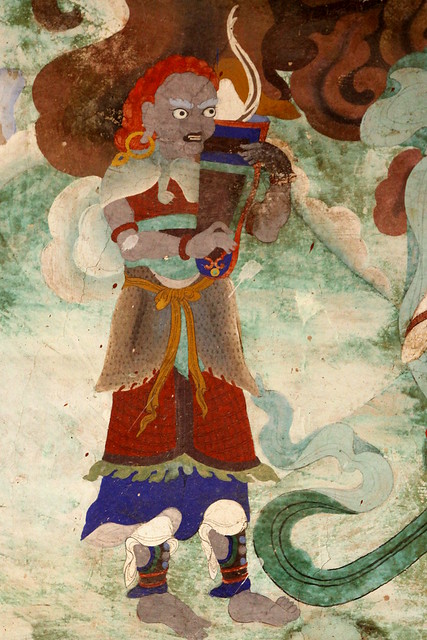Qu’est-ce Un Guru?
Par Sa Divine Grâce A.C. Bhaktivedanta Swami Prabhupada
om ajnana-timirandhasya
jnananjana-salakaya
caksur unmilitam yena
tasmai sri-gurave namah
« Je suis né dans les plus profondes ténèbres de l’ignorance et mon guru, mon maître spirituel m’a ouvert les yeux avec le flambeau de la connaissance. Je lui rends mon hommage respectueux. »
Le mot ajnana signifie ‘ignorance’ ou ‘ténèbres’. Si toutes les lumières dans cette chambre sont éteintes soudainement, nous ne pourrons pas voir où se tiennent toutes les personnes. Tous seront mis dans la confusion. De même, nous nous trouvons dans l’obscurité dans ce monde matériel, qui est le monde du tamas. Tamas ou timira signifie ‘obscurité’. Cet univers matériel est plein de ténèbres, et nécessite donc la lumière du soleil ou de la lune pour illumination. Par contre, il existe un autre univers, lui spirituel, au-delà de cette obscurité.
Ce monde est décrit par Sri Krishna dans la Bhagavad-gita (15.6) :
na tad bhasayate suryo
na sasanko na pavakah
yad gatva na nivartante
tad dhama paramam mama
« Ce royaume suprême, le Mien, ni le soleil, ni la lune, ni la force électrique ne l’éclairent. Pour qui l’atteint, point de retour en ce monde. »
L’affaire du guru est de ramener ses disciples de l’obscurité vers la lumière. A ce moment tout le monde souffre à cause de l’ignorance, comme lorsqu’on devient infecté d’une maladie par ignorance. Si on ne connait pas les principes d’hygiène, on deviendra malade. C’est par ignorance donc que nous souffrons nos maladies. Un homme criminel dira « Je ne connaissais pas la loi ! »; mais il ne sera pas excusé s’il commet un crime. L’ignorance n’est pas une excuse.
De la même manière, un enfant qui ne sait pas que le feu brûle voudra toucher le feu. Le feu ne pense pas, « Oh ! C’est un enfant, et il ne sait pas que je peux le brûler. » Non, il n’y pas d’excuse. De même que l’état a ses lois, la nature a ses lois strictes, et ces lois agiront en dépits de notre ignorance. Si, dans notre ignorance, nous commettons du mal, nous devrons souffrir les conséquences. C’est la loi. Que se soit la loi de l’état ou la loi de la nature, nous devrons souffrir si nous la transgressons.
L’affaire du guru est de voir que nul être humain ne souffre dans ce monde matériel. Aucun ne peut déclarer qu’il n’a point de souffrance. Ce n’est pas possible. Dans le monde matériel, il existe trois sortes de souffrances : adhyatmika, adhibhautika, and adhidaivika. Ce sont les misères qui surviennent du corps matériel et du mental, des autres entités vivantes, et des forces de la nature.
On pourrait souffrir à cause d’une angoisse, ou bien on pourrait souffrir à cause d’autres entités vivantes – des fourmis ou des moustiques ou des mouches – ou on pourrait souffrir à cause d’une force supérieure. Il pourrait y avoir la sécheresse ou bien un déluge. On pourrait avoir trop chaud ou bien trop froid. Toutes sortes de souffrances nous sont imposées dans le monde matériel, et tous sont sujets à une, deux ou trois de ces formes de misères. Aucune personne ne peut dire qu’elle est complètement libre de toute souffrance.
On pourrait se demander pourquoi l’entité vivante souffre. La réponse : l’ignorance. Elle ne pense pas, « Je commets des erreurs, et ma vie est pleine de péchés ; c’est la raison pour laquelle je souffre. » Le premier but du guru est de délivrer son disciple de cette ignorance. Nous envoyons nos enfants à l’école pour qu’ils n’aient pas a souffrir. Si nos enfants ne reçoivent pas une éducation, nous craignons qu’ils souffrirons dans le futur.
Le guru peut voir que la souffrance est causé par l’ignorance, qui se compare aux ténèbres. Comment est-ils possible que quelqu’un dans l’obscurité puisse se délivrer ? Avec la lumière. Le guru prend le flambeau de la connaissance et le présente à l’entité vivante gisant dans l’obscurité. Cette connaissance le libère des souffrances des ténèbres de l’ignorance.
On pourrait se demander si un guru est absolument nécessaire. Les écrits Védiques nous indiquent dans l’affirmative :
tad-vijnanartham sa gurum evabhigacchet
samit-panih srotriyam brahma-nistham
[MU 1.2.12]
Les écrits Védiques nous prescrivent de rechercher un guru ; en fait, ils disent de chercher LE guru, et non seulement un guru. Le guru est un, parce qu’il vient dans la succession disciplique. Ce que Vyasadeva et Krishna enseignèrent il y a 5 000 ans est enseigné aussi a présent. Il n’y a aucune différence entre les deux instructions. Bien que des centaines et des milliers d’acaryas [précepteurs spirituels] soient venus et partis, le message demeure le même. Le vrai guru ne peut être deux, car le vrai guru ne parle pas différemment de ses prédécesseurs.
Certains enseignants spirituels disent, « Mon opinion est que tu devrais faire ceci », mais ils ne sont pas gurus. Ces soi-disant gurus sont seulement des coquins. Le véritable guru n’a qu’une seule opinion, et c’est l’opinion de Krishna , de Vyasadeva, de Narada, Arjuna, Sri Caitanya Mahaprabhu et les Gosvamis. Il y a cinq mille ans, le Seigneur Sri Krishna énonça la Bhagavad-gita, et Vyasadeva l’a mise par écrit. Srila Vyasadeva n’a pas dit, « Voici mon opinion. » Au contraire, il écrivit, « sri bhagavan uvaca », c’est-a-dire, « le Seigneur Bienheureux dit. » Ce que Vyasadeva inscrivait fut originellement énoncé par la Personnalité Suprême de Dieu. Srila Vyasadeva n’exprimait pas son opinion.
Par conséquent, Srila Vyasadeva est un guru. Il n’interprète pas les paroles de Krishna, mais les transmets telle qu’elles ont été énoncées. Si nous envoyons un télégramme, la personne qui remet le télégramme n’a nul besoin de le corriger, le rédiger, ou bien d'y ajouter quelque chose. Il n’a seulement qu’a le remettre. Voici donc l’affaire du guru. Le guru pourra être telle ou telle personne, mais le message demeure le même ; il est donc dit que le guru est un.
Dans la succession disciplique, nous trouvons toujours la répétition du même sujet. Dans la Bhagavad-gita (9.34) Sri Krishna dit :
man-mana bhava mad-bhakto
mad-yaji mam namaskuru
mam evaisyasi yuktvaivam
atmanam mat-parayanah
« Emplis toujours de Moi ton mental, deviens mon dévot, offre-Moi ton hommage et voue-Moi ton adoration. Parfaitement absorbe en Moi, certes tu viendras à Moi. »
Ces mêmes instructions furent réitérées par tous les acaryas, tels Ramanujacarya, Madhvacarya, et Caitanya Mahaprabhu. Les six Gosvamis ont aussi transmit le même message, et nous suivons dans leurs traces. Il n’y a aucune différence. Nous n’interprétons pas les paroles de Krishna en disant, « Dans mon opinion, la Bataille de Kuruksetra représente le corps humain. » Telles interprétations sont présentées par des coquins. Dans le monde, il y a beaucoup de gurus coquins qui présentent leurs propres opinions, mais nous défions tous ces coquins.
Un guru coquin dira, « Je suis Dieu », ou bien, « Nous sommes tous Dieu. » Tout ceci est bel et bien, mais nous devrions trouver la définition du mot ‘Dieu’ dans le dictionnaire. Généralement le dictionnaire indiquera que le mot ‘Dieu’ signifie l’Etre Suprême. On pourra donc demander à tel guru, « Est-tu la Personne Suprême ? » S’il ne peut nous comprendre, nous lui donnerons le sens du mot ‘suprême’. Le dictionnaire nous informe que ‘suprême’ signifie ‘la plus haute autorité’.
On pourra donc demander, « Est-tu la plus haute autorité ? » Un tel guru coquin, en se proclamant Dieu lui-même, ne peut répondre à notre question. Dieu est l’Etre Suprême et la plus haute autorité. Personne ne Lui est égal ni supérieur. Pourtant il y a tellement de guru-dieux, tellement de coquins qui se proclament l’Etre Suprême. De tels coquins ne pourront pas nous aider a échapper les ténèbres de l’existence matérielle. Ils ne peuvent illuminer notre obscurité avec le flambeau de la connaissance spirituelle.
Le guru authentique présentera simplement ce que dit le guru suprême, Dieu, dans les écritures authentiques. Un guru ne peut pas changer le message de la succession disciplique. On doit comprendre que l’on ne peut pas faire la recherche pour trouver la Vérité Absolue. Caitanya Mahaprabhu Lui-même dit, « Mon Guru Maharaja, Mon maitre spirituel, m’a considéré un grand imbécile. » Celui qui demeure un grand imbécile face à son propre guru est un guru lui-même.
Mais, si quelqu’un déclare, « Je suis maintenant si avancé que je peux parler mieux que mon guru », il est un coquin. Dans la Bhagavad-gita (4.2) Sri Krishna dit :
evam parampara-praptam
imam rajarsayo viduh
sa kaleneha mahata
yogo nastah parantapa
« Savoir suprême, transmit de maître à disciple, voilà comment les saints rois l’ont reçu et réalisé. Mais au fils du temps, O vainqueurs des ennemis, la succession disciplique s’est rompue, et cette science, en son état de pureté, semble maintenant perdue. »
Accepter un guru n’est pas une question de mode. Celui qui est sérieux pour comprendre la vie spirituelle requière un guru. Le guru est une question de besoin, car l’on doit être très sérieux pour comprendre la vie spirituelle, Dieu, l’action propice, et la relation vis-à-vis de Dieu. Quand nous serons très sérieux pour comprendre ces sujets, nous aurons besoin d’un guru. Nous ne devons pas aller au guru simplement parce que c’est la mode. La soumission doit y être, car sans la soumission nous ne pourrons rien apprendre. Si nous allons voir le guru uniquement pour le défier, nous n’apprendrons rien du tout.
Nous devons accepter le guru dans la même manière qu’Arjuna a accepté son guru, Sri Krishna Lui-même :
karpanya-dosopahata-svabhavah
prcchami tvam dharma-sammudha-cetah
yac chreyah syan niscitam bruhi tan me
sisyas te 'ham sadhi mam tvam prapannam
« La défaillance m’a fait perdre ton mon sang-froid ; je ne vois plus où est mon devoir. Indique-moi clairement où est la voie juste. Je suis à présent Ton disciple et m’en remets à Toi ; éclaire-moi, je T’en prie. (Bhagavad-gita 2.7)
Voici donc le processus pour accepter un guru. Le guru est le représentant de Krishna, le représentant des acaryas précédant. Krishna dit que tous les acaryas sont Ses représentants ; donc au guru doit être offert le même respect que nous offrons à Dieu. Selon Visvanatha Cakravarti Thakura dans ses prières au maître spirituel, « yasya prasadad bhagavat-prasadah – par la miséricorde du maître spirituel on reçoit la bénédiction de Krishna. » Ainsi, en nous remettant au guru authentique, nous nous soumettons à Dieu. Dieu accepte notre soumission au guru.
Dans la Bhagavad-gita (18.66) Krishna instruit:
sarva-dharman parityajya
mam ekam saranam vraja
aham tvam sarva-papebhyo
moksayisyami ma sucah
« Laisse là toute autre forme de religion, et abandonne-toi simplement à Moi. Toutes les suites de tes fautes Je t’en affranchirai. N’aie nul crainte. »
Quelqu’un pourra discuter, « Où est Krishna ? Je vais me soumettre à Lui. » Mais non, le procède est que d’abord on se soumet au représentant de Krishna ; par la suite on se soumet à Krishna. Il est donc dit, « saksad-dharitvena samasta-sastraih »: le guru est équivalent à Dieu. Quand nos offrons nos respects au guru, nous offrons nos respects à Dieu. Parce que nous essayons d’être conscient de Dieu, il est nécessaire que nous apprenions a offrir nos respects à Dieu a travers le représentant de Dieu. Dans toutes les écritures, le guru est décrit comme étant équivalent à Dieu, mais le guru ne déclare jamais, « Je suis Dieu. »
Le devoir du disciple est d’offrir les respects à son guru tout comme il offre ses respects à Dieu, mais le guru ne pense jamais, « Mes disciples m’offrent le même respect qu’ils accordent à Dieu ; je suis donc devenu Dieu. » Aussitôt qu’il pense de cette façon, il devient un chien au lieu de Dieu. C’est pourquoi Visvanatha Cakravarti dit, « kintu prabhor yah priya eva tasya. » Parce qu’il est le serviteur le plus confidentiel de Dieu, le guru est offert le même respect que Dieu.
Dieu est toujours Dieu, le guru est toujours le guru. Selon l’étiquette, Dieu est le Dieu adorable, et le guru est le Dieu adorateur [sevaka-bhagavan]. Le guru est donc adressé du nom de Prabhupada. Le mot prabhu signifie ‘seigneur’ and pada signifie ‘position’. C’est ainsi que Prabhupada veut dire ‘celui qui a pris la position du Seigneur.’ C’est la même chose que saksad- dharitvena samasta-sastraih.
Le guru est nécessaire seulement si nous sommes très sérieux de comprendre la science de Dieu. Nous ne devrions pas essayer de maintenir un guru parce que c’est la mode. Celui qui a accepté un guru parle avec intelligence. Il ne parle jamais le non-sens. Voilà le signe d’avoir acceptéun guru authentique. Nous devons certes offrir tous nos respects au maître spirituel, mais aussi nous devons nous souvenir comment accomplir ses ordres.
Dans la Bhagavad-gita (4.34) Sri Krishna Lui-même nous dit la méthode de chercher et de s’approcher du guru:
tad viddhi pranipatena
pariprasnena sevaya
upadeksyanti te jnanam
jnaninas tattva-darsinah
« Cherche a connaître la vérité en approchant un maître spirituel ; enquiers-toi d’elle auprès de lui avec soumission, et tout en le servant. L’âme réalisée peut te révéler le savoir car elle a vu la vérité. »
Le premier processus est celui de la soumission. Nous devons trouver un personnage exalté et volontairement nous soumettre devant lui. Les sastras [écritures] nous enseignent qu’avant d’accepter un guru, nous devons l’étudier soigneusement pour déterminer si nous pouvons nous soumettre à lui. Nous ne devons pas accepter un guru soudainement, par fanatisme. Ce serait dangereux.
Le guru lui aussi étudie la personne qui désire devenir son disciple pour voir s’il est qualifié. C’est de cette façon que la relation est établie entre le guru et le disciple. Toutes choses sont prévues, mais nous devons suivre le procède sérieusement. Ainsi nous pouvons être formés à devenir un disciple authentique. D’abord nous devons trouver un guru authentique, établir notre relation avec lui, et agir en accord avec ses instructions. C’est alors que notre vie sera un succès, car le guru peut éclairer le disciple sincère qui se trouve dans l’ignorance.
Tous sont nés fripons et sots. Si nous naissons en pleine connaissance, pourquoi aurions-nous besoin d’aller à l’école ? Si nous ne cultivons pas la connaissance, nous ne sommes pas mieux que les animaux. Un animal pourra dire qu’il n’a pas besoin de livres, et qu’il est devenu guru, mais comment est-ce possible d’obtenir la connaissance sans étudier les livres autorisés de science et de philosophie ? Les gurus coquins évitent toutes ces choses.
Nous devons comprendre que nous sommes tous nés fripons et sots et que nous avons besoin d’être éclairci. Nous devons recevoir la connaissance pour perfectionner notre vie. Si nous ne perfectionnons pas notre vie, nous sommes vaincus. Qu’elle est cette défaite ? La lutte pour l’existence. Nous essayons d’améliorer notre vie, d’obtenir une meilleure position, and pour ceci nous nous exerçons avec grande difficulté. Mais en fait, nous ne savons pas quelle est la position supérieure.
Toute position dans ce monde matériel doit être abandonnée. Notre position peut être bonne ou mauvaise ; dans tout cas, nous ne pouvons pas demeurer ici. Nous pourrions gagner des milliers de dollars et penser « Maintenant je suis dans une bonne situation », mais une petite dysenterie ou une choléra nous ôtera de notre situation. En fait, il n’y a pas de bonne situation dans le monde matériel. C’est une farce. Tous ceux qui essayent d’atteindre une meilleure position dans le monde matériel sont ultimement vaincus, parce qu’une meilleure position n’y existe pas.
La Bhagavad-gita (14.26) nous montre quelle est la meilleure position :
mam ca yo 'vyabhicarena
bhakti-yogena sevate
sa gunan samatityaitan
brahma-bhuyaya kalpate
« Celui qui tout entier s’absorbe dans le service de dévotion, sans jamais faillir, transcende des lors les trois gunas et atteint par là le niveau du brahman. »
Y’a-t-il une science qui nous donne la connaissance par laquelle nous pouvons devenir immortels ? Oui, nous pouvons devenir immortels mais non pas dans le sens matériel. On ne peut pas recevoir cette connaissance dans les soi-disant universités. Néanmoins, il existe une connaissance contenue dans les écrits védiques par laquelle nous pouvons devenir immortels. Cette immortalité est la meilleure position. Plus de naissance, plus de morts, plus de vieillesse, plus de maladie. Le maître spirituel accepte une très grande responsabilité. Il doit guider son disciple et lui faciliter l’opportunité d’atteindre la position parfaite – l’immortalité. Le guru doit être compétent pour mener son disciple de retour à Krishna, la Personnalité Suprême de Dieu.

